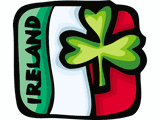
OSBORNE, LAVERY AND LEECH (A TRIO OF FAMOUS IRISH PAINTERS)
~~~~~~~~~~~~~~~~~~~~~~~~~~~~~~~~~~~~~~~~~~~~~~~~~~~~~~~~~~~
Walter Osborne was born in 1859. He painted mainly in the
French Brittany region of Quimperlé but moved to England
in 1884. His paintings of rural scenes that dominated his
early years gradually gave way to an 'impressionistic'
interpretation of those subjects that he had great empathy
for, namely women, small children and old people. His
superb images of young girls at play are still cherished
by the National Gallery of Ireland: The Dolls School, The
House Builders.
John Lavery was born in Belfast but was educated in
Glasgow, London and Paris. He originally worked as an
apprentice photographer but harboured ambitions to be
a portrait artist. He became an official war artist and
eventually a chronicler of his times with paintings such
as 'The Ratification of the Irish Treaty in the English
House of Lords, 1921' and 'Blessing of the Colors: A
Revolutionary Soldier Kneeling to the Blessed'. His most
famous work was perhaps that of his wife, Lady Lavery,
'The Red Rose' which was a painting that had a number of
incarnations before it forever bore the face of the woman
who was to adorn the Irish Pound note for half a century.
William John Leech was born in Dublin in 1881 and studied
under Walter Osborne at the Royal Hibernian Academy
Schools. He became increasingly interested in sunlight
and shadow and this perhaps might explain why the famous
painting 'The Goose Girl' was acredited to him. So proud of
this wonderful interpretation of a girl in a bluebell field
was the National Gallery of Ireland that they adopted the
image as their logo, only to finally have to accept that
the painting was in fact completed by the Englishman
Stanley Royle. He can be regarded as one of the great
Irish colorists' as can be seen by his superb image: 'Les
Soeurs du Saint-Esprit, Concarneau, c. 1910-1912' which
has to be one of the finest Irish paintings ever.
View the paintings of these artists at the Site at:
<a href="http://www.ireland-information.com/picturesofireland/picturesofireland.htm">http://www.ireland-information.com/picturesofireland/picturesofireland.htm</a>
~~~~~~~~~~~~~~~~~~~~~~~~~~~~~~~~~~~~~~~~~~~~~~~~~~~~~~~~~~
(C) Copyright The Information about Ireland Site, 2000
The Leader in Free Resources from Ireland
Free Irish coats of arms, screensavers, maps and more
http://www.ireland-information.com
~~~~~~~~~~~~~~~~~~~~~~~~~~~~~~~~~~~~~~~~~~~~~~~~~~~~~~~~~~


